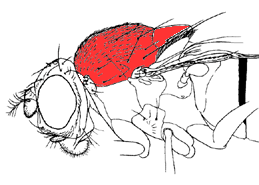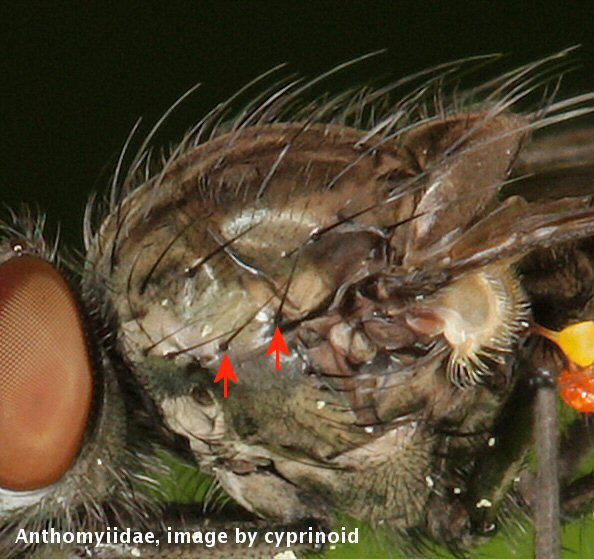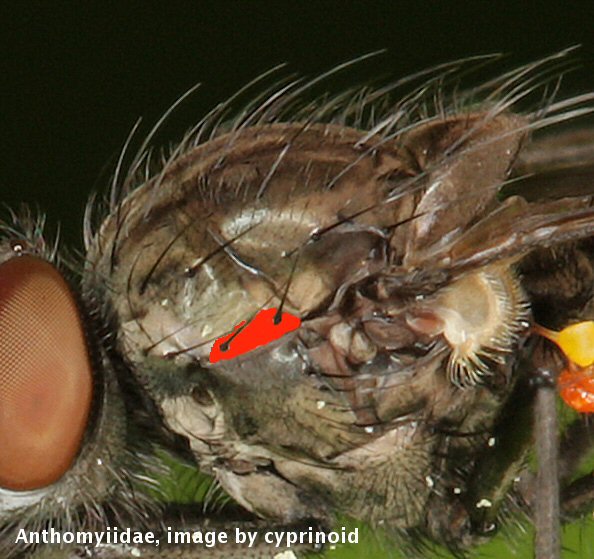|
M |
| mesonotum |
The thorax is composed of three basic segments of which the second (mesothorax is the largest. The mesonotum is the dorsal part of the mesothorax and it constitutes most of the dorsal part of the thorax. It is composed of the prescutum (not differentiated in most Diptera, except for some Nematocera), the scutum![header=[scutum] body=[The mesonotum is composed of three parts: the prescutum (not differentiated in most Diptera, except for some Nematocera), the scutum and the scutellum. The largest of these three is the scutum which is usually divided by a suture in an anterior part and a posterior part, the presutural and postsutural areas, respectively.<br />
<br />
Image courtesy of Japan Drosophila Database (http://www.dgrc.kit.ac.jp/~jdd/bodyparts/index.html)<br /><img src='http://www.diptera.info/infusions/terms/images/scutum.gif' style='vertical-align:middle;' />] delay=[0] fade=[on]](../../infusions/terms/images/help.gif) and the scutellum. and the scutellum.
Image courtesy of Japan Drosophila Database |

|
| mesopleuron |
| anepisternum (synonym) |
| metatarsus |
| first tarsomere (synonym) |
| misident. |
abbreviation of misidentification![header=[misidentification] body=[In taxonomy: taxonomic names for biological species are sometimes widely misunderstood or misinterpreted. Such species may later be referred to under the wrong name, often that of a sister species. This is quite different from synonymy where the same biological species has two or more names. However misidentifications are often listed in synonymies (lists of synonyms) and sometimes there is confusion between the two.<br />
For example in Ulidiidae:<br />
Homalocephala albitarsis Zetterstedt, 1838 = bipunctata (Loew, 1854)<br />
Homalocephala biumbrata (Wahlberg, 1838) = albitarsis Zetterstedt, 1838: misident. sensu auct.<br />
In the first case two different names have been appled to the same species. These are synonyms.<br />
In the second case unspecified authors have misidentified what is really biumbrata as albitarsis.<br />
In general: Misidentification can also mean an error of identification which does not enter the literature.<br /><img src='../../infusions//terms/images/no_image.gif' style='vertical-align:middle;' />] delay=[0] fade=[on]](../../infusions/terms/images/help.gif) |
| misidentification |
In taxonomy: taxonomic names for biological species are sometimes widely misunderstood or misinterpreted. Such species may later be referred to under the wrong name, often that of a sister species![header=[sister species] body=[The Glossary contains no matching items.<br />It may have been added using different lettering,<br />so you can click the Term to check this.<br />Otherwise, contact the Administrator to report this error.<br /><img src='../../infusions//terms/images/no_image.gif' style='vertical-align:middle;' />] delay=[0] fade=[on]](../../infusions/terms/images/help.gif) . This is quite different from synonymy . This is quite different from synonymy![header=[synonymy] body=[1. Being a synonym of another taxon.<br />
2. List of synonyms, as in list of different names that have been applied to the same taxon.<br /><img src='../../infusions//terms/images/no_image.gif' style='vertical-align:middle;' />] delay=[0] fade=[on]](../../infusions/terms/images/help.gif) where the same biological species has two or more names. However misidentifications are often listed in synonymies (lists of synonyms) and sometimes there is confusion between the two. where the same biological species has two or more names. However misidentifications are often listed in synonymies (lists of synonyms) and sometimes there is confusion between the two.
For example in Ulidiidae:
Homalocephala albitarsis Zetterstedt, 1838 = bipunctata (Loew, 1854)
Homalocephala biumbrata (Wahlberg, 1838) = albitarsis Zetterstedt, 1838: misident. sensu auct.
In the first case two different names have been appled to the same species. These are synonyms![header=[synonyms] body=[synonym<br /><img src='../../infusions//terms/images/no_image.gif' style='vertical-align:middle;' />] delay=[0] fade=[on]](../../infusions/terms/images/help.gif) . .
In the second case unspecified authors have misidentified what is really biumbrata as albitarsis.
In general: Misidentification can also mean an error of identification which does not enter the literature. |
| mosquito |
Vernacular name flies of the family Culicidae.
Links: http://en.wikiped...i/Mosquito
|
| mounting |
The preparation of a specimen to that it can be identified and stored in an insect collection. Two common ways to mount insects are pinning and slide mounting. In the first case a pin is put through the insect, as a rule through the thorax. This is then done either though the mesonotum or through the sides of the thorax (side pinning). In the second case the insect is usually mascerated (softened) and embedded in a mounting fluid before it is covered by a cover glas and sealed. In both cases the specimen should be positioned in such a way that necessary characters for identification are visible (for example by spreading the legs and wings and by extracting genitalia) and the specimens should be properly labeled (locality, date, collector, identification).
Links: Online Manual on Collecting and Mounting from Transvaal Museum: go to Equipment for pin details etc; to Preservation for mounting methods; Insect Collection from Massingale's Biology Place. |
| mydas flies |
Vernacular name for the family Mydidae.
Links: http://en.wikiped.../Mydas_fly. |
| myiasis |
The invasion of living tissues of man and other vertebrates by dipterous larvae.
Links: http://en.wikiped...ki/Myiasis;
Two unpublished cases of myiasis |
N |
| name-bearing type |
The type genus, type species![header=[type species] body=[The nominal species that is the name-bearing type of a nominal genus or subgenus. (From the Glossary of the International Code of Zoological Nomenclature) (http://www.diptera.info/weblinks.php?cat_id=5&weblink_id=72).<br /><img src='../../infusions//terms/images/no_image.gif' style='vertical-align:middle;' />] delay=[0] fade=[on]](../../infusions/terms/images/help.gif) , holotype , holotype![header=[holotype] body=[The single specimen designated or otherwise fixed as the name-bearing type of a nominal species or subspecies when the nominal taxon is established. (From the Glossary of the International Code of Zoological Nomenclature) (http://www.diptera.info/weblinks.php?cat_id=5&weblink_id=72).<br /><img src='../../infusions//terms/images/no_image.gif' style='vertical-align:middle;' />] delay=[0] fade=[on]](../../infusions/terms/images/help.gif) , lectotype , lectotype![header=[lectotype] body=[A syntype designated as the single name-bearing type specimen subsequent to the establishment of a nominal species or subspecies. (From the Glossary of the International Code of Zoological Nomenclature) (http://www.diptera.info/weblinks.php?cat_id=5&weblink_id=72).<br /><img src='../../infusions//terms/images/no_image.gif' style='vertical-align:middle;' />] delay=[0] fade=[on]](../../infusions/terms/images/help.gif) , series of syntypes , series of syntypes![header=[syntypes] body=[syntype<br /><img src='../../infusions//terms/images/no_image.gif' style='vertical-align:middle;' />] delay=[0] fade=[on]](../../infusions/terms/images/help.gif) (which together constitute the name-bearing type) or neotype (which together constitute the name-bearing type) or neotype![header=[neotype] body=[The single specimen designated as the name-bearing type of a nominal species or subspecies when there is a need to define the nominal taxon objectively and no name-bearing type is believed to be extant. If stability and universality are threatened, because an existing name-bearing type is either taxonomically inadequate or not in accord with the prevailing usage of a name, the Commission may use its plenary power to set aside that type and designate a neotype. (From the Glossary of the International Code of Zoological Nomenclature) (http://www.diptera.info/weblinks.php?cat_id=5&weblink_id=72).<br /><img src='../../infusions//terms/images/no_image.gif' style='vertical-align:middle;' />] delay=[0] fade=[on]](../../infusions/terms/images/help.gif) that provides the objective standard of reference whereby the application of the name of a nominal taxon that provides the objective standard of reference whereby the application of the name of a nominal taxon![header=[nominal taxon] body=[A concept of a taxon which is denoted by an available name (e.g. Mollusca, Diptera, Bovidae, Papilio, Homo sapiens). Each nominal taxon in the family, genus or species groups is based on a name-bearing type (although in the latter two groups such a type may not have been actually fixed). (From the Glossary of the International Code of Zoological Nomenclature) (http://www.diptera.info/weblinks.php?cat_id=5&weblink_id=72).<br /><img src='../../infusions//terms/images/no_image.gif' style='vertical-align:middle;' />] delay=[0] fade=[on]](../../infusions/terms/images/help.gif) can be determined. (From the Glossary of the International Code of Zoological Nomenclature). can be determined. (From the Glossary of the International Code of Zoological Nomenclature). |
| Nearctic |
One of the eight terrestrial ecozones dividing the Earth's land surface.The Nearctic ecozone covers most of North America, including Greenland and the highlands of Mexico.
Not included are Southern Mexico, southern Florida, Central America, and the Caribbean islands which are are part of the Neotropic ecozone, together with South America.
Links: http://en.wikiped...i/Nearctic.
|
| nec |
Latin: 'and not' (of); 'nor' (of), used to distinguish from a homonym![header=[homonym] body=[In nomenclature the word homonym is used for identical but independently proposed names for the same or different taxa. For exampe: Ochromyia Lehrer, 2005 is a homonym of Ochromyia Macquart, 1835. As a rule, the junior (more recent) name (in this case Ochromyia Lehrer, 2005) is invalid.<br />
<br /><img src='../../infusions//terms/images/no_image.gif' style='vertical-align:middle;' />] delay=[0] fade=[on]](../../infusions/terms/images/help.gif) . For example: Cheilosia antiqua Becker, 1894 nec (Meigen, 1822) indicates that the taxon . For example: Cheilosia antiqua Becker, 1894 nec (Meigen, 1822) indicates that the taxon![header=[taxon] body=[Plural: taxa.<br />
Systematic category used in scientific, biological classification, like species or family. For example, in Diptera, the family Tipulidae is one taxon, as is the genus Tipula and the species Tipula maxima. These taxa represent different levels in a hierarchical scheme. A taxon at a certain level usually exists of more taxa at a lower level (for example, species in a genus).<br />
<br /><img src='../../infusions//terms/images/no_image.gif' style='vertical-align:middle;' />] delay=[0] fade=[on]](../../infusions/terms/images/help.gif) described by Becker (1894) as antiqua Meigen, 1822 is not the same taxon as Meigen (1822) himself described under the name antiqua. described by Becker (1894) as antiqua Meigen, 1822 is not the same taxon as Meigen (1822) himself described under the name antiqua. |
| neotype |
The single specimen designated as the name-bearing type![header=[name-bearing type] body=[The type genus, type species, holotype, lectotype, series of syntypes (which together constitute the name-bearing type) or neotype that provides the objective standard of reference whereby the application of the name of a nominal taxon can be determined. (From the Glossary of the International Code of Zoological Nomenclature) (http://www.diptera.info/weblinks.php?cat_id=5&weblink_id=72).<br /><img src='../../infusions//terms/images/no_image.gif' style='vertical-align:middle;' />] delay=[0] fade=[on]](../../infusions/terms/images/help.gif) of a nominal species or subspecies when there is a need to define the nominal taxon objectively and no name-bearing type is believed to be extant. If stability and universality are threatened, because an existing name-bearing type is either taxonomically inadequate or not in accord with the prevailing usage of a name, the Commission may use its plenary power to set aside that type and designate a neotype. (From the Glossary of the International Code of Zoological Nomenclature). of a nominal species or subspecies when there is a need to define the nominal taxon objectively and no name-bearing type is believed to be extant. If stability and universality are threatened, because an existing name-bearing type is either taxonomically inadequate or not in accord with the prevailing usage of a name, the Commission may use its plenary power to set aside that type and designate a neotype. (From the Glossary of the International Code of Zoological Nomenclature). |
| nominal taxon |
A concept of a taxon![header=[taxon] body=[Plural: taxa.<br />
Systematic category used in scientific, biological classification, like species or family. For example, in Diptera, the family Tipulidae is one taxon, as is the genus Tipula and the species Tipula maxima. These taxa represent different levels in a hierarchical scheme. A taxon at a certain level usually exists of more taxa at a lower level (for example, species in a genus).<br />
<br /><img src='../../infusions//terms/images/no_image.gif' style='vertical-align:middle;' />] delay=[0] fade=[on]](../../infusions/terms/images/help.gif) which is denoted by an available name (e.g. Mollusca, Diptera, Bovidae, Papilio, Homo sapiens). Each nominal taxon in the family, genus or species groups is based on a name-bearing type which is denoted by an available name (e.g. Mollusca, Diptera, Bovidae, Papilio, Homo sapiens). Each nominal taxon in the family, genus or species groups is based on a name-bearing type![header=[name-bearing type] body=[The type genus, type species, holotype, lectotype, series of syntypes (which together constitute the name-bearing type) or neotype that provides the objective standard of reference whereby the application of the name of a nominal taxon can be determined. (From the Glossary of the International Code of Zoological Nomenclature) (http://www.diptera.info/weblinks.php?cat_id=5&weblink_id=72).<br /><img src='../../infusions//terms/images/no_image.gif' style='vertical-align:middle;' />] delay=[0] fade=[on]](../../infusions/terms/images/help.gif) (although in the latter two groups such a type may not have been actually fixed). (From the Glossary of the International Code of Zoological Nomenclature). (although in the latter two groups such a type may not have been actually fixed). (From the Glossary of the International Code of Zoological Nomenclature). |
| notopleural seta |
| notopleural setae (synonym) |
| notopleural setae |
Setae placed on the notopleuron![header=[notopleuron] body=[Lateral part of the mesonotum immediately posterior of postpronotal lobes. The notopleuron may be carrying several setae, the notopleural setae. If these are present it may be possible to distinguish between the anterior notopleural setae and the posterior notopleural setae. Presence, absence and number of notopleural setae may be of diagnostic and systematic importance.<br /><img src='http://www.diptera.info/infusions/terms/images/notopleuron.jpg' style='vertical-align:middle;' />] delay=[0] fade=[on]](../../infusions/terms/images/help.gif) . If larger notopleural setae are present it may be possible to distinguish between the anterior notopleural setae . If larger notopleural setae are present it may be possible to distinguish between the anterior notopleural setae![header=[anterior notopleural setae] body=[Large setae placed on the anterior part of the notopleuron, immediately posterior of the postpronotal lobe.<br /><img src='http://www.diptera.info/infusions/terms/images/ant_notopleural_seta.jpg' style='vertical-align:middle;' />] delay=[0] fade=[on]](../../infusions/terms/images/help.gif) and the posterior notopleural setae and the posterior notopleural setae![header=[posterior notopleural setae] body=[Large setae placed on the posterior part of the notopleuron, immediately anterior of the mesonotal suture.<br /><img src='http://www.diptera.info/infusions/terms/images/post_notopleural_seta.jpg' style='vertical-align:middle;' />] delay=[0] fade=[on]](../../infusions/terms/images/help.gif) . Presence, absence and number of notopleural setae may be of diagnostic and systematic importance. . Presence, absence and number of notopleural setae may be of diagnostic and systematic importance. |

|
| notopleuron |
Lateral part of the mesonotum![header=[mesonotum] body=[The thorax is composed of three basic segments of which the second (mesothorax is the largest. The mesonotum is the dorsal part of the mesothorax and it constitutes most of the dorsal part of the thorax. It is composed of the prescutum (not differentiated in most Diptera, except for some Nematocera), the scutum and the scutellum.<br />
<br />
Image courtesy of Japan Drosophila Database (http://www.dgrc.kit.ac.jp/~jdd/bodyparts/index.html)<br /><img src='http://www.diptera.info/infusions/terms/images/mesonotum.gif' style='vertical-align:middle;' />] delay=[0] fade=[on]](../../infusions/terms/images/help.gif) immediately posterior of postpronotal lobes immediately posterior of postpronotal lobes![header=[postpronotal lobes] body=[The Glossary contains no matching items.<br />It may have been added using different lettering,<br />so you can click the Term to check this.<br />Otherwise, contact the Administrator to report this error.<br /><img src='../../infusions//terms/images/no_image.gif' style='vertical-align:middle;' />] delay=[0] fade=[on]](../../infusions/terms/images/help.gif) . The notopleuron may be carrying several setae, the notopleural setae . The notopleuron may be carrying several setae, the notopleural setae![header=[notopleural setae] body=[Setae placed on the notopleuron. If larger notopleural setae are present it may be possible to distinguish between the anterior notopleural setae and the posterior notopleural setae. Presence, absence and number of notopleural setae may be of diagnostic and systematic importance.<br /><img src='http://www.diptera.info/infusions/terms/images/notopleural_setae.jpg' style='vertical-align:middle;' />] delay=[0] fade=[on]](../../infusions/terms/images/help.gif) . If these are present it may be possible to distinguish between the anterior notopleural setae . If these are present it may be possible to distinguish between the anterior notopleural setae![header=[anterior notopleural setae] body=[Large setae placed on the anterior part of the notopleuron, immediately posterior of the postpronotal lobe.<br /><img src='http://www.diptera.info/infusions/terms/images/ant_notopleural_seta.jpg' style='vertical-align:middle;' />] delay=[0] fade=[on]](../../infusions/terms/images/help.gif) and the posterior notopleural setae and the posterior notopleural setae![header=[posterior notopleural setae] body=[Large setae placed on the posterior part of the notopleuron, immediately anterior of the mesonotal suture.<br /><img src='http://www.diptera.info/infusions/terms/images/post_notopleural_seta.jpg' style='vertical-align:middle;' />] delay=[0] fade=[on]](../../infusions/terms/images/help.gif) . Presence, absence and number of notopleural setae may be of diagnostic and systematic importance. . Presence, absence and number of notopleural setae may be of diagnostic and systematic importance. |

|
O |
| obsolete name |
This is a name that is no longer used (or widely accepted) in systematics/nomenclature. Obsolete family names are the most problematic.
Links: http://en.wikiped...in_Diptera. |
| occiput |
| Posterior surface of the head (back of the head). Synonym: postcranium. |
| ocellar bristles |
A pair of bristles that usually arise from the ocellar triangle near the anterior ocellus but that are sometimes displaced, usually outside the ocellar triangle near the anterior ocellus.
The image is a temporary link to:
http://upload.wikimedia.org/wikipedia/commons/c/cf/Head-diptera-muscoidfly.gif |

|












![header=[scutum] body=[The mesonotum is composed of three parts: the prescutum (not differentiated in most Diptera, except for some Nematocera), the scutum and the scutellum. The largest of these three is the scutum which is usually divided by a suture in an anterior part and a posterior part, the presutural and postsutural areas, respectively.<br />
<br />
Image courtesy of Japan Drosophila Database (http://www.dgrc.kit.ac.jp/~jdd/bodyparts/index.html)<br /><img src='http://www.diptera.info/infusions/terms/images/scutum.gif' style='vertical-align:middle;' />] delay=[0] fade=[on]](../../infusions/terms/images/help.gif)



